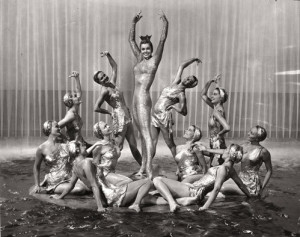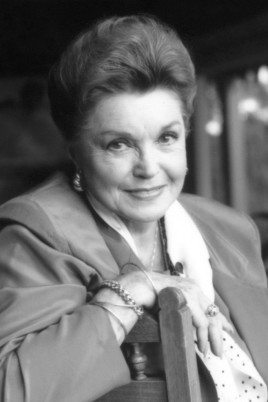 Born in Los Angeles, Esther Williams grew up swimming in playground pools and surfing at local beaches. By age 16, she represented the powerful Los Angeles Athletic Club swim team and had earned three national championships in both the breaststroke and freestyle. She was on the 1940 Olympic team headed for Tokyo when World War II intervened, canceling the games – along with her hopes for the gold and international fame.
Born in Los Angeles, Esther Williams grew up swimming in playground pools and surfing at local beaches. By age 16, she represented the powerful Los Angeles Athletic Club swim team and had earned three national championships in both the breaststroke and freestyle. She was on the 1940 Olympic team headed for Tokyo when World War II intervened, canceling the games – along with her hopes for the gold and international fame.
Still, she was attracting attention in other ways. In 1940 newspaper sports reportage, swimmers were frequently lined up for cheesecake photos, flashing big smiles and lots of leg. With her stunning good looks and tall, well-muscled frame, Esther was a standout! It didn’t take long for legendary showman Billy Rose to notice the photogenic champion. Rose needed a female lead to star opposite Olympian and screen star Johnny Weismuller in his San Francisco Aquacade review. He invited Williams up for an audition and, so the story goes, Weismuller himself picked her out of a casting call of 75 hopefuls. Her performing career had begun.
The Aquacade was a true spectacle – a Broadway musical in swimsuits complete with hundreds of swimmers, divers, singing and special effects. Williams was featured as Aquabelle #1, performing choreographed duet swims with Aquadonis #1 (Weismuller).
In a memo to his publicity department. Rose explained, “I want to pivot everything around Williams. It is up to us to make this girl known up and down the coast. With the possible exception of Eleanor HoIm (the 1936 Olympic swimmer who was also Rose’s wife), she’s the most beautiful swimming champion in the history of aquatics.”
MGM executives who saw her in the Aquacade agreed. They offered Williams a screen test – paired with none other than Clark Gable. Gable liked her, the studio liked her, and she was signed to a contract. She made her film debut opposite Mickey Rooney in Andy Hardy’s Double Life in 1942.

As Williams explains, “The popular Andy Hardy series movies were MGM’s tests for its promising stars such as Judy Garland, Lana Turner and Donna Reed. If you didn’t make it in those pictures, you were never heard from again.”
The audience response to the athletic All-American girl was phenomenal, and the studio put Williams’ career into high gear. Midway through filming Mr. Coed with Red Skelton, they changed the name of the movie to Bathing Beauty and made Esther Williams the star, demoting Skelton to supporting lead.
Bathing Beauty was Hollywood’s first swimming movie, and it created a new genre that was perfectly suited to Esther’s beauty and athletic skills. A special 90-foot square, 20-foot deep pool was built at Stage 30 on the MGM lot, complete with hydraulic lifts, hidden air hoses and special camera cranes for overhead shots.
“No one had ever done a swimming movie before,” she explains, “so we just made it up as we went along. I ad-libbed all my own underwater movements.” Famous choreographer Busby Berkeley was responsible for the film’s elaborate water scenes – complete with fountains, flames, smoke and, as Williams herself admits, lots of pretty girls swimming around with bows in their hair. It worked. According to Williams, Bathing Beauty was second only to Gone with the Wind as the most successful film of 1944.
During the mid-40s, the MGM musicals were the most popular form of entertainment in the world. By the tail end of World War II, Williams was a pinup favorite with returning Gl’s. Meanwhile, MGM’s publicity mill kept churning out headlines and photo opportunities – she once counted 14 magazines on a local newsstand featuring her picture on the cover. Esther Williams was America’s sweetheart for more than 18 years, appearing in 26 movies from the early 1940s to the end of the ’50s, all but the last few for MGM.
 Although she had a few dry-land roles in such films as Take Me Out to the Ball Game, it was the lavish water spectaculars that made her a top box-office draw and that became her cinematic trademark. Like ice skater Sonja Henie before her, Williams was one of the few female athletes to successfully cross over to widespread entertainment success. Her movie career played a major role in the promotion of competitive and synchronized swimming, which she is credited with popularizing. As International Swimming Hall of Fame literature explains, “If swimming would make his daughter grow up to look like Esther Williams, then father was willing to pay for the lessons.”
Although she had a few dry-land roles in such films as Take Me Out to the Ball Game, it was the lavish water spectaculars that made her a top box-office draw and that became her cinematic trademark. Like ice skater Sonja Henie before her, Williams was one of the few female athletes to successfully cross over to widespread entertainment success. Her movie career played a major role in the promotion of competitive and synchronized swimming, which she is credited with popularizing. As International Swimming Hall of Fame literature explains, “If swimming would make his daughter grow up to look like Esther Williams, then father was willing to pay for the lessons.”
Although movie making was exhausting work – Williams estimates that she swam more than 1,000 collective miles while making her movies and was in the water so many hours each day that she took naps with her legs on the pool deck and her head floating in the water – she found time to marry four times and have three children (Benjamin, Kimball and Susan) during her second marriage to radio singer Ben Gage.
“I don’t know to this day how I managed to fit into those bathing suits when I was pregnant,” she says, “but I did.” She still refers to each child by the movie she was making before they were born. “There I was, diving off platforms with Ben in Neptune’s Daughter, going underwater in silver lame’ with Kim in Pagan Love Song and learning how to water ski with Susie in Easy to Love…and somehow I stayed a size 10 through it all.”
Williams showed that she had a head for enterprise between those broad swimmer’s shoulders. “I got into business because I knew those musicals couldn’t go on forever. In fact, I was doing some department store modeling at the time, and I told my bosses to hold my job. This movie-making thing wouldn’t last. I mean, how many swimming movies could they make?”
When someone came to her with the idea of putting her name on a line of backyard swimming pools, she agreed. Then came licensing agreements with fashion swimwear manufacturers that ultimately led to her own Esther Williams Collection, which she designed with the comfort of women in mind — making them look beautiful at the same time.

Williams has had a full life as an athlete, movie star, mother, and businesswoman. She’s an inspiration to millions. But the one thing that binds it all together, the one thing that always keeps her going, is her connection to water and to swimming. “I think the joy that showed through in my swimming movies comes from my lifelong love of the water,” she explains. “No matter what I was doing, the best I felt all day was when I was swimming.”
Then there’s her relationship with her children, all three of whom she taught to swim soon after birth. That’s part of her philosophy about the magic of water. “One of the reasons I gave them this gift of swimming so early in their lives was because I loved having them with me in the water. And when I saw them take to it, it was a shared joy that we had in common.
Asked if she still swims, she laughed. “You know, I always get asked that. Of course I still swim. I’ll go in later when I have the pool to myself.”
Reprinted in part from the July / August, 1994 issue of “Competitor For Women” – article by Harald Johnson
Leave a comment